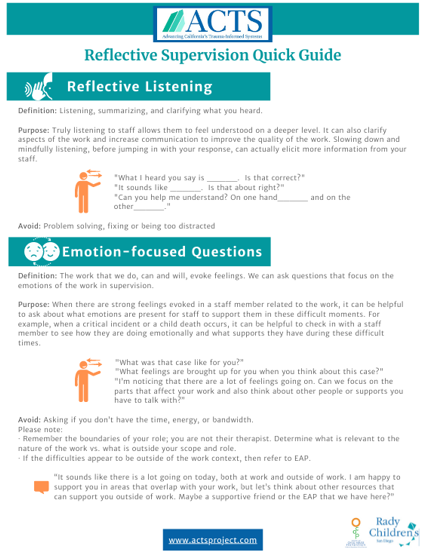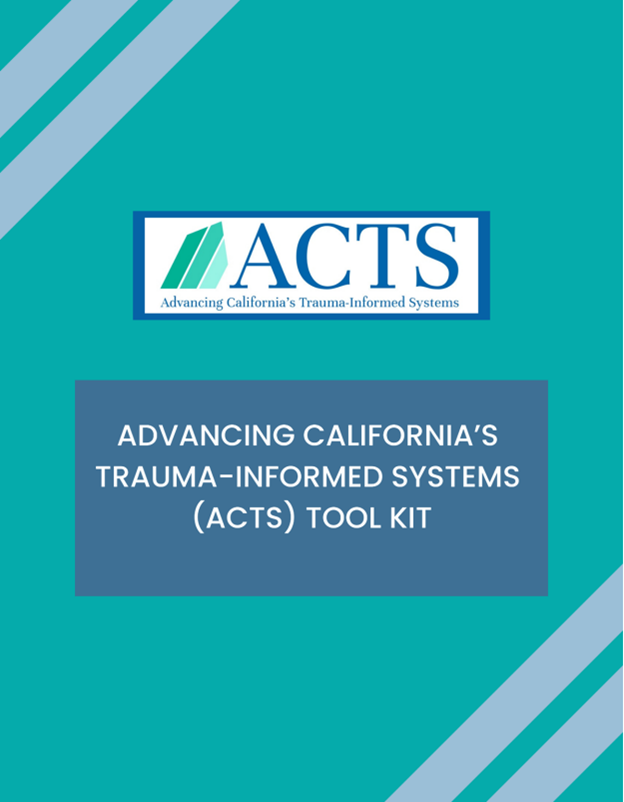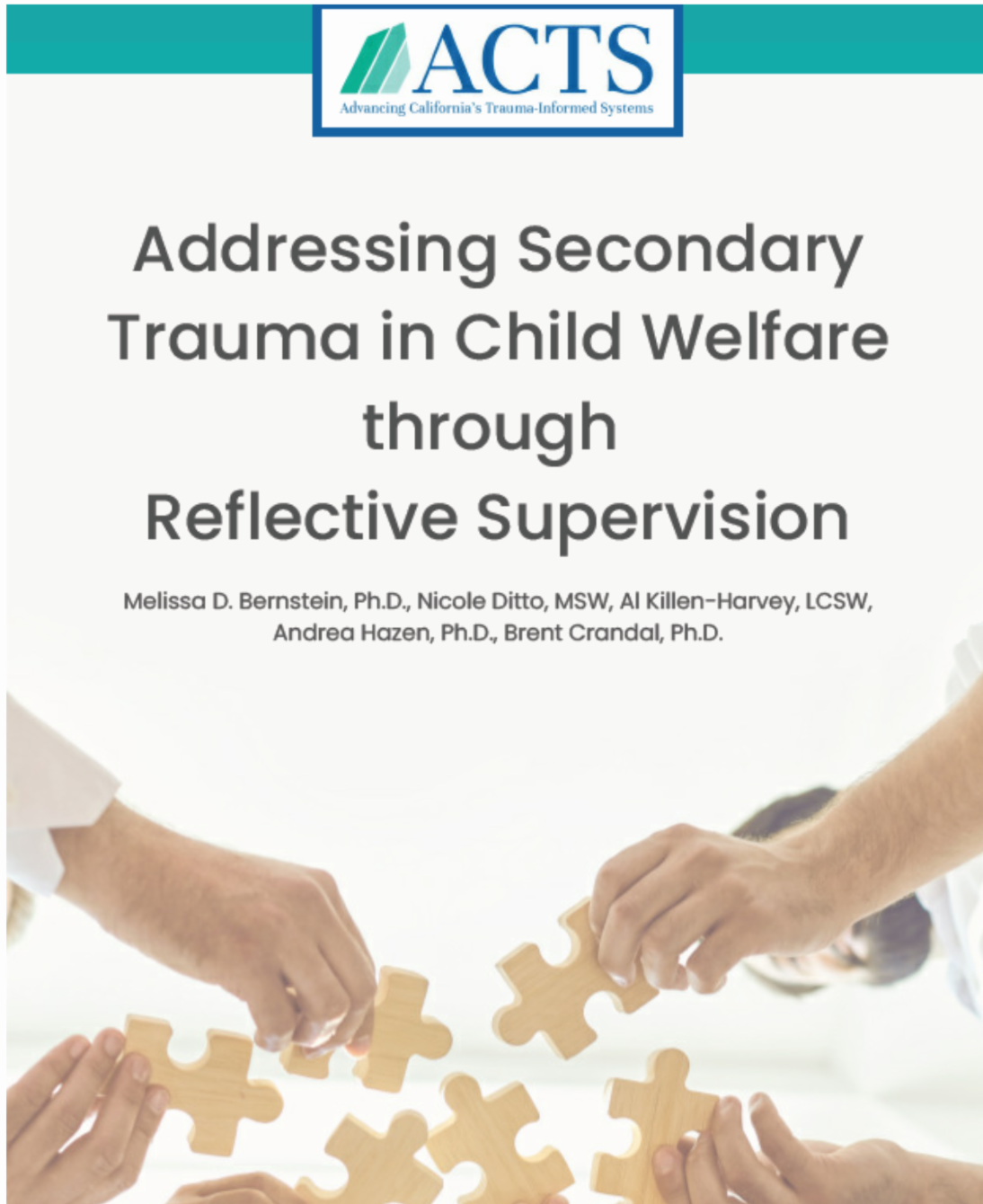Resources for Prevention and Intervention of Secondary Traumatic Stress
“The expectation that we can be immersed in suffering and loss daily and not be touched by it is as unrealistic as expecting to be able to walk through water without getting wet.” – Kitchen Table Wisdom by Rachel Naomi Remen.
Secondary traumatic stress (STS) is frequently used to refer to the indirect trauma that can occur when you are exposed to the firsthand trauma experiences of others. This exposure may result from seeing the impact of trauma on children and families, reading details of traumatic experiences, or seeing stories about mass violence in the news.
Studies show that 6% to 26% of therapists working with traumatized populations and up to 50% of child welfare workers are at high risk of secondary traumatic stress or the related conditions of PTSD and vicarious trauma (NCTSN).
Each year, millions of children across the country endure the trauma of abuse, violence, natural disasters, and other adverse events (NCTSN). These experiences can give rise to significant emotional and behavioral problems that can profoundly disrupt the children’s lives and bring them in contact with child-serving professionals. For therapists, child welfare workers, case managers, social workers, and other helping professionals involved in caring for traumatized children and their families, the essential act of listening to trauma stories may take an emotional toll that compromises professional functioning and diminishes the quality of life.
Between 40% and 85% of “helping professionals” develop vicarious trauma, compassion fatigue, and/or high rates of traumatic symptoms. (Mathieu, 2012). In a sample of social workers, 15.2% met the full criteria for PTSD due to indirect trauma exposure (Bride, 2007).
According to the Quality Improvement Center for Workforce Development (QIC-WD), the typical response to exposure to ongoing stress and trauma is to go into survival mode, also known as the “fight, flight, or freeze” instinct. Survival mode is extremely useful in emergencies because it quickly takes over all other functions to help protect us from the perceived threat. However, in non-emergency situations, survival mode can be harmful for child- and family-serving professionals. Survival mode can be switched on when working in a crisis-driven environment, and it can be difficult to switch off. This can take a toll on a person’s body and mind.
What does survival mode look like? There are a variety of symptoms to look for:

It’s important for child- and family-serving professionals to be aware of, monitor, and control the activation of survival mode when they are under a lot of stress. Agency leadership can also support and protect their workforce from burnout caused by secondary traumatic stress through both policy and practice. To help guide agency leadership and individuals impacted by secondary traumatic stress, CalTrin has curated a list of free resources available from local, state, and national partners:
California Training Institute (CalTrin)
Hey, that’s us! CalTrin regularly partners with Dr. Lisa Conradi, Executive Director, Chadwick Center for Children & Families at Rady Children’s Hospital–San Diego, and Dr. Melissa Bernstein, Director of Advancing California’s Trauma-Informed Systems (ACTS) project at Rady Children’s Hospital–San Diego, for training focused on identifying and addressing secondary traumatic stress in the workplace. Access recordings and materials from prior trainings, and check out the calendar for future webinars and workshops! You can also explore our relevant self-paced courses and resource collections.
- Training Archive– Revisit recordings and materials from prior CalTrin trainings:
- An Introduction to Child Trauma
- Becoming a Trauma-Informed Leader: Preparing for Change at the Personal & Team Level
Trauma, Compassion Fatigue, & Secondary Traumatic Stress - Organizational Strategies: Addressing Compassion Fatigue & Secondary Traumatic Stress
- Trauma-Informed Organizations
- Secondary Traumatic Stress and Reflective Practice/Supervision
- Trauma-Informed Care 101: Understanding Your Role in Creating a Trauma-Informed Environment
- Trauma-Informed Leadership: The Balance of Compassion & Accountability
- Empathic Strain & Secondary Trauma 101: Understanding the Essentials
Note: You will need to log in to your CalTrin account to access the self-paced courses and select archived training materials. You can create a free account here.
Advancing California’s Trauma-Informed Systems (ACTS)
The ACTS project is a collaboration between the California Department of Social Services (CDSS) Office of Child Abuse and Prevention (OCAP) and the Chadwick Center at Rady Children’s Hospital–San Diego. ACTS supports child-serving systems in finding their unique path to advance innovative, trauma-informed change that will support the workforce and lead to improved outcomes for children and families.
ACTS provides dedicated resources to help child- and family-serving professionals address secondary traumatic stress (STS). The cost of secondary traumatic stress impacts not only the well-being of individuals but also the well-being of child-serving organizations, leading to high turnover and burnout. The ACTS project has developed a system-focused strategy to prevent, intervene, and address secondary traumatic stress through a model of reflective supervision. For individuals interested in learning about reflective supervision as a way to address secondary trauma, view resources, tools, and trainings developed by the ACTS team online here. Find information on partnering with ACTS online here.
ACTS also developed a series of learning videos to support child-serving systems in advancing trauma-informed practices. Each series consists of 3-5 microlearning videos with a discussion guide to facilitate continued conversation and learning:
- Psychological Safety Video Series
- Introduction to Child Trauma
- Trauma-Informed Interviewing
- Reflective Practice and Supervision
Staff members at children’s advocacy centers (CACs) and their multi-disciplinary team (MDT) partners are at the forefront of a community’s response to child abuse and neglect. While this work undoubtedly presents key intrinsic rewards, it can also take its toll. You may have heard terms such as vicarious trauma (VT), burnout, secondary traumatic stress (STS), or compassion fatigue used to describe this impact. Dr. Lisa Conradi, Executive Director of the Chadwick Center for Children and Families, authored a piece on why providing ongoing support and resources is essential to helping CAC staff and their MDT partners stay engaged in this important work. Read Addressing the Health and Well-Being of Children’s Advocacy Center Staff and Partners.
California Evidence-Based Clearinghouse for Child Welfare (CEBC)
Our partner project, the California Evidence-Based Clearinghouse for Child Welfare (CEBC), promotes the effective implementation of evidence-based practices for children and families involved with the child welfare system. The CEBC developed a brief guide on Addressing Secondary Traumatic Stress that is applicable across all child- and family-serving organizations. According to the CEBC, secondary traumatic stress should be addressed throughout the life of the child welfare workforce, beginning with recruitment, continuing through their tenure with the agency, and concluding with an exit interview process whenever a staff member leaves the agency. Their guide is based on the National Child Traumatic Stress Network’s comprehensive Secondary Traumatic Stress in Child Welfare Practice: Trauma-Informed Guidelines for Organizations report (Chadwick Trauma-Informed Systems Dissemination and Implementation Project, 2016). Download the CEBC’s guide here.
NEW: The CEBC’s Secondary Traumatic Stress (STS) Prevention & Intervention Programs Topic Area features programs that are designed to prevent the onset of STS or reduce its impact on those already affected. View all programs reviewed by the CEBC for this topic here.
Child Welfare Information Gateway
People with careers in the helping professions, like child welfare workers and child welfare-related professionals, are particularly vulnerable to experiencing secondary traumatic stress (STS). The Child Welfare Information Gateway’s Workforce topic features resources related to recruiting and supporting stable child welfare workforces, training and supporting workers, and addressing issues related to recruitment, workloads, and turnover.
Mental Health America (MHA)
Research shows that the workplace has a significant impact on our mental health. In fact, 78% of workers in the Mental Health America 2022 Mind the Workplace report agreed that workplace stress affected their mental health, and 7 in 10 workers found it difficult to concentrate. This stress can negatively affect the personal well-being, productivity, job satisfaction, and retention of workers. MHA and Walgreens partnered to create the Mental Health Toolkit: Creating a Culture of Support and Well-Being. In this toolkit, learn how employers and people in leadership can develop or improve existing workplace policies that uplift workers, ensure they are valued and heard, and improve an organization’s overall culture of well-being. Download the toolkit.
National Child Traumatic Stress Network (NCTSN)
According to NCTSN, secondary traumatic stress (STS) development is recognized as a common occupational hazard for professionals working with traumatized children. To promote individual and supervisory awareness of and build resilience against the effects of this indirect trauma exposure, NCTSN has developed secondary traumatic stress resources (fact sheets, guides, webinars, etc.) available in both English and Spanish. To get started, review the Introduction to Secondary Traumatic Stress section of the website and explore these resources:
- Secondary Traumatic Stress: A Fact Sheet for Child-Serving Professionals
- Secondary Traumatic Stress: Understanding the Impact on Professionals in Trauma-Exposed Workplaces
- Pause-Reset-Nourish (PRN)* to Promote Wellbeing: Use as Needed to Care for Your Wellness!
- Pausa – Restablecer – Nutrir (PRN)* para promover el bienestar ¡Utilícelo según sea necesario para cuidar su bienestar!
- Psychological First Aid Guide for Child Advocacy Center Supervisors
National Child Welfare Workforce Institute (NCWWI)
Child welfare programs should engage in trauma-informed training to prepare their staff to work with families who have experienced multiple traumas. NCWWI’s Trauma-informed Practice Resource Library is a searchable database of more than 80 tools and resources from state and national partners that will help guide organizations and systems in planning for, implementing, and sustaining a trauma-informed organizational change. Get started with their one-page summary on secondary traumatic stress and explore all resources here.
For additional resources related to employee retention and burnout among the child welfare workforce, explore NCWWI’s Burnout Resource Library. Get started with these two NCWWI resources: How Hope and Resilience Can Lower Burnout Among Child Welfare Workers one-pager and Child Welfare Can Address Burnout infographic.
Employee Assistance Plan (EAP)
An Employee Assistance Program (EAP) is a voluntary, work-based program offering free and confidential assessments, short-term counseling, referrals, and follow-up services to employees with personal and/or work-related problems. Professionals working in child- and family-serving agencies should explore supports available through the EAP at your agency. Further, it’s important to acknowledge that not all EAPs offer services to volunteers or have counselors with an awareness of and training on the impact of secondary traumatic stress and vicarious trauma. To complement this type of service, an organization may want to establish an employee and volunteer assistance program (EVAP), an internal vicarious trauma-informed resource for staff and volunteers. Learn more about the benefits of EVAPs in this report commissioned by the Office for Victims of Crime, Guidelines for a Vicarious Trauma-Informed Organization: Employee and Volunteer Assistance Program.
Additional Resources & Recommended Readings
Sesame Workshop: Taking Care of Myself Webinar (*certificate available) and Taking Care of Yourself Worksheet Series
ProQOL (Professional Quality of Life): Measures the negative and positive effects of helping others who experience suffering and trauma. The ProQOL has sub-scales for compassion satisfaction, burnout, and compassion fatigue.
TEND Toolkit: Searchable database of tools, strategies, and education to support helping professionals working in complex workplaces.
ZERO TO THREE: Buzzwords Explained: Compassion Fatigue
Extend Your Learning with CalTrin!
CalTrin’s Trauma-Informed Systems learning domain features training on trauma and trauma-related practices. Topics include designing and managing trauma-informed service systems and agencies, including addressing the impact of secondary traumatic stress on the workforce and ensuring that all services are trauma-informed. Be sure to check out upcoming trainings!
*Last updated June 21, 2024



